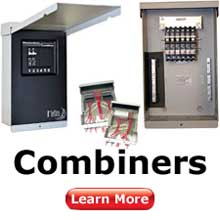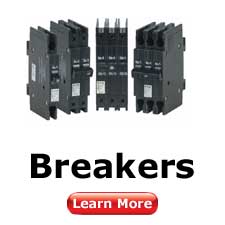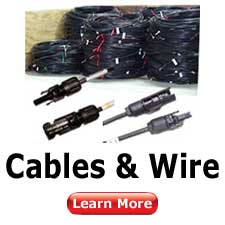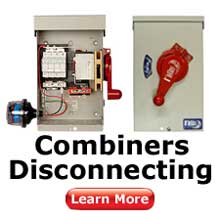Related Items; Racks, Solar Batteries & Electrical Distribution for Solar Kits Total Cost
Solar Features and Benefits
CIRCUIT VOLTAGE AND CURRENT Protection Devices
Each year, dozens of homes in this country are burned to the ground due to fires as a result of faulty electrical wiring. Millions of dollars worth of properties and even people's lives are lost in some cases. What's worse is that most of these accidents could easily have been prevented had the homeowners given more attention to electrical wiring safety through the proper use of combiners, circuit breakers and other UL listed electrical distribution protection.
Combiners, Circuit Breakers, Electrical Distribution, Wire, Cables
Considering Solar Array Components
![]() Solar panels produce direct current. Controllers, batteries, monitors, fuse boxes, inverters and
circuit breakers using the overall electrical distribution help transfer that current into a grid tie or off-grid home. For off-grid applications, from the solar panel, electricity should travel to a combiner to a charge controller to a battery bank. The controller helps manage the amount of
electricity entering the nodes. When the battery is fully charged, the current from the panel is either restricted or can be diverted somewhere else such backfeeding in some cases to the utility grid. Photovoltaic systems with battery banks give homes the
flexibility of using stored electricity during grid outages which otherwise with a grid-tie system would stop functioning without the grid.
Solar panels produce direct current. Controllers, batteries, monitors, fuse boxes, inverters and
circuit breakers using the overall electrical distribution help transfer that current into a grid tie or off-grid home. For off-grid applications, from the solar panel, electricity should travel to a combiner to a charge controller to a battery bank. The controller helps manage the amount of
electricity entering the nodes. When the battery is fully charged, the current from the panel is either restricted or can be diverted somewhere else such backfeeding in some cases to the utility grid. Photovoltaic systems with battery banks give homes the
flexibility of using stored electricity during grid outages which otherwise with a grid-tie system would stop functioning without the grid.
Electrical Distribution; Getting to Know a Solar Array
When it comes to solar installations, business is booming. With plummeting costs, increasing efficiency, and plenty of government incentives, more homeowners are considering solar power every year. Electrical Distribution, DC current, PV wire circuit breakers and main panels, it's time to get to know a solar array.
A solar array is first and foremost a collection of solar panels. Each of these solar panels consists of a collection of individual solar cells. These solar cells are simple slabs of specially treated crystalline silicon. During the manufacturing process, trace elements are added to the silicon mixture, leading to an overall positive or negative charge in the material. One half of a solar cell is formed from the positively charged mixture, and the other half from its negatively charged counterpart.
Once the two halves are joined, a flow of electrons from the positively charged side streams towards the negatively charged half. Eventually, a neutral barrier will form between the two halves, halting the electrical flow. When the cell is exposed to sunlight, photons from the sun's rays strike the solar cell, knocking electrons loose from their atoms and disrupting this neutral barrier enough to restart the electrical flow.
Multiple solar cells are then fitted next to one another and enclosed within a frame, becoming a single solar panel. In order to harvest the electrical flow from the cells, a network of metallic wiring is installed, connecting with each individual cell and leading to a larger wire at the edge of the panel. This large wire terminates in a socket on the frame, which will be used to connect each individual solar panel into the overall solar array via Electrical Distribution; combiners, circuit Breakers, wire and PV cables.
At this point the electricity from the solar panel is flowing as a Direct Current, or DC. This means the electrical flow is moving in a single, continuous direction. Modern standards for usage of electricity require an Alternating Current, or AC. In contrast to DC power, AC power "cycles" the direction of its flow back and forth dozens of times every second. This constant reversal "tames" the current, allowing it to be more easily manipulated and monitored by the various components of an electrical grid.
In order to convert the DC power flowing from the panels into AC power suitable for the home's wiring, an inverter is used. This device will impose the required AC power cycling onto the existing DC electrical flow. In some systems, each individual solar panel will be wired to a single inverter that handles this conversion for the entire solar array. An alternative exists in the form of "micro-inverters," which are simply smaller inverters that handle the AC power conversion for each individual solar panel.
Once the electrical flow has been converted to AC power it's ready to enter the home. In solar installations that do not include battery storage, this happens immediately. The power will flow from the inverter into the home's existing electrical meter, and will either be distributed into the home's wiring, or diverted back to the power company's electrical grid if it's not required at that moment.
Solar arrays that are off the grid or otherwise make use of a battery storage system require an additional step before being fed into the batteries. If the home's meter decides that the electricity is not required immediately, it will be diverted to a Solar Charge Controller, also known as a Battery Controller. This device regulates the flow of electricity to and from the system's batteries, ensuring that each individual battery is charged and discharged in a safe and regimented manner.
Through this process a small amount of electricity harvested from an individual solar cell can be combined with many others into solar panels and via electrical distribution the overall solar array in order to provide for a grid tie or off-grid home's energy needs.
Doing your own home wiring or solar electrical distribution is very rewarding and can save you a lot of money. While you must always use caution when dealing with any kind of electricity, special precautions working with DC as well as AC electrical circuits need to be taken to avoid serious injury and death. The following three steps must always be taken before working on any project in your home.
Solar Features and Benefits
- DYI Solar Panels
- Cost of Solar Batteries
- Net Metering Panel Kit
- Federal Solar Tax Credits
- Battery Systems
- Solar Backup Costs
- Buy Solar Batteries
- Installing Water Heating Panels
- Commercial Systems
- Solar Energy Installation
- Powerpack Solar Panel Cost
- Home Kits, Off-grid Systems
- Roof Ground Mount
- Utility Rebates
- Best Solar Batteries




